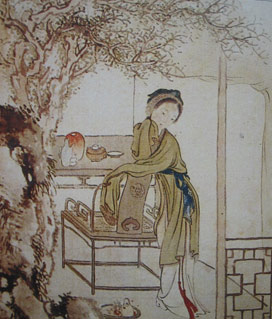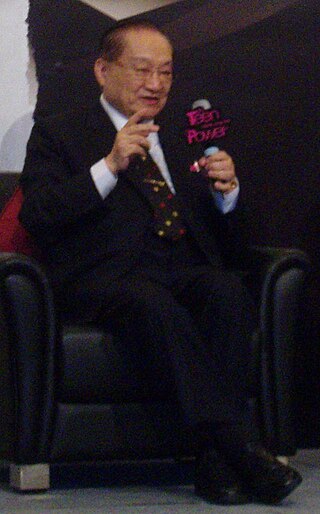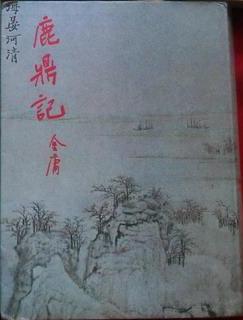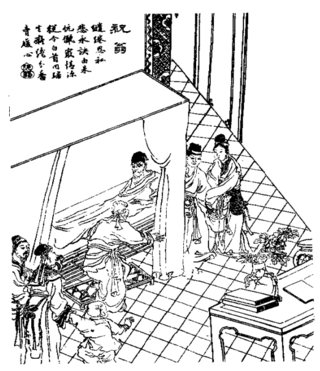Chinese classic texts or canonical texts or simply dianji (典籍) refers to the Chinese texts which originated before the imperial unification by the Qin dynasty in 221 BC, particularly the "Four Books and Five Classics" of the Neo-Confucian tradition, themselves a customary abridgment of the "Thirteen Classics". All of these pre-Qin texts were written in classical Chinese. All three canons are collectively known as the classics.

The Soong sisters, Soong Ai-ling, Soong Ching-ling, and Soong Mei-ling, were three sisters from Wenchang city, Hainan Island of Hainan Province). Along with their husbands they became among China's most significant political figures of the early 20th century. The sisters, all educated as Christians, played a major role in influencing their husbands, leaders of Nationalist China: Sun Yat Sen, Chiang Kai-shek, and H. H. Kung. Along with their own positions of power, these marriages ultimately changed the course of Chinese history.

Rosamond Soong Ch'ing-ling was a Chinese political figure. As the third wife of Sun Yat-sen, then Premier of the Kuomintang and President of the Republic of China, she was often referred to as Madame Sun Yat-sen. She was a member of the Soong family and, together with her siblings, played a prominent role in China's politics prior to and after 1949.

Dream of the Red Chamber or The Story of the Stone is a novel composed by Cao Xueqin in the middle of the 18th century. One of the Four Great Classical Novels of Chinese literature, it is known for its psychological scope, and its observation of the worldview, aesthetics, life-styles, and social relations of 18th-century China.

Cáo Xuěqín ; was a Chinese novelist and poet during the Qing dynasty. He is best known as the author of Dream of the Red Chamber, one of the Four Great Classical Novels of Chinese literature. His given name was Cáo Zhān (曹霑) and his courtesy name was Mèngruǎn.

Soong Ai-ling, legally Soong E-ling or Eling Soong was a Chinese businesswoman, the eldest of the Soong sisters and the wife of H. H. Kung, who was the richest man in the early 20th century Republic of China. The first character of her given name is written as 靄 in some texts. Her Christian name was Nancy.

Charles Jones Soong, also known by his courtesy name Soong Yao-ju, was a Chinese businessman who first achieved prominence as a publisher in Shanghai. He was a close friend and follower of Sun Yat-sen during the Xinhai Revolution of 1911. His children became some of the most prominent figures in Republican China.

Louis Cha Leung-yung, better known by his pen name Jin Yong, was a Chinese wuxia novelist and essayist who co-founded the Hong Kong daily newspaper Ming Pao in 1959 and served as its first editor-in-chief. He was Hong Kong's most famous writer, and is named along with Gu Long and Liang Yusheng as the "Three Legs of the Tripod of Wuxia".

James Legge was a Scottish linguist, missionary, sinologist, and translator who was best known as an early translator of Classical Chinese texts into English. Legge served as a representative of the London Missionary Society in Malacca and Hong Kong (1840–1873) and was the first Professor of Chinese at Oxford University (1876–1897). In association with Max Müller he prepared the monumental Sacred Books of the East series, published in 50 volumes between 1879 and 1891.

The Classic of Poetry, also Shijing or Shih-ching, translated variously as the Book of Songs, Book of Odes, or simply known as the Odes or Poetry, is the oldest existing collection of Chinese poetry, comprising 305 works dating from the 11th to 7th centuries BCE. It is one of the "Five Classics" traditionally said to have been compiled by Confucius, and has been studied and memorized by scholars in China and neighboring countries over two millennia. It is also a rich source of chengyu that are still a part of learned discourse and even everyday language in modern Chinese. Since the Qing dynasty, its rhyme patterns have also been analysed in the study of Old Chinese phonology.

Lionel Giles was a British sinologist, writer, and philosopher. Lionel Giles served as assistant curator at the British Museum and Keeper of the Department of Oriental Manuscripts and Printed Books. He is most notable for his 1910 translations of The Art of War by Sun Tzu and The Analects of Confucius.

The Deer and the Cauldron, also known as The Duke of Mount Deer, is a historical comedy novel by Jin Yong. It is the longest of his novels. Although the last to be published, it is the eighth of twelve in internal order. It was initially published in Hong Kong as a serial, running from 24 October 1969 to 23 September 1972 in the newspaper Ming Pao.
David Hawkes was a British sinologist and translator. After being introduced to Japanese through codebreaking during the Second World War, Hawkes studied Chinese and Japanese at Oxford University between 1945 and 1947 before studying at Peking University from 1948 to 1951. He then returned to Oxford, where he completed his D.Phil. and later became Shaw Professor of Chinese. In 1971, Hawkes resigned his position to focus entirely on his translation of the famous Chinese novel The Story of the Stone, which was published in three volumes between 1973 and 1980. He retired in 1984 to rural Wales before returning to Oxford in his final years.

"The Painted Skin" is a short story by the Chinese writer Pu Songling collected in Strange Tales from a Chinese Studio in 1740. Literary critics have recognised it as one of the best and best-known entries in Strange Tales; in particular, its textual detail and in-depth characterisation are lauded. "The Painted Skin" has also received numerous adaptations in popular media, especially in film. The story's original title has become a common phrase in Chinese vocabulary, "a synonym for duplicity that wears an outwardly human face but is inwardly demonic".
The four big families of the Republic of China are four politically influential families in the Republic of China, first in Mainland China, then Taiwan. They were responsible for much of China's management of finance, politics, economy, and law. The four big families begin with the Chinese surnames Chiang, Soong, Kung, and Chen.
Brian Holton is the translator of Chinese "Misty" poet Yang Lian. He translates into English and Scots, and is the only currently-publishing Chinese-Scots translator in the world.
Zhiyanzhai was the pseudonym of an early and mysterious commentator of the 18th-century Chinese novel Dream of the Red Chamber. This person was a contemporary of the author Cao Xueqin who knew the author intimately enough to be regarded as the chief commentator of his work while it was still unpublished. Most early hand-copied manuscripts of the novel contain red or black-inked commentaries by a few unknown commentators, considered authoritative enough to be transcribed by scribes into subsequent generations of copies. Zhiyanzhai was the most prominent of these commentators. Early copies of Dream were known as 脂硯齋重評石頭記. These versions are known as 脂本, or "Rouge Versions", in Chinese. They are the manuscripts with the highest textual reliability.
D. C. Lau was a Chinese sinologist and author of the widely read translations of Tao Te Ching, Mencius and The Analects and contributed to the Proper Cantonese pronunciation movement.

"Old Man Zhu" is a short story by Pu Songling, first published in Strange Tales from a Chinese Studio (1740). It revolves around the titular gentleman who returns from the dead to fetch his wife.












